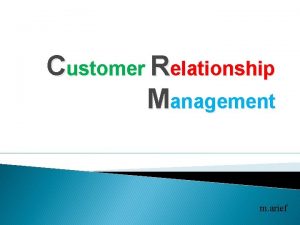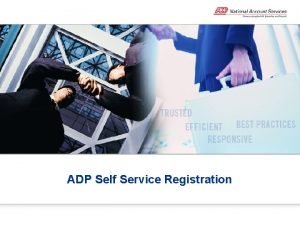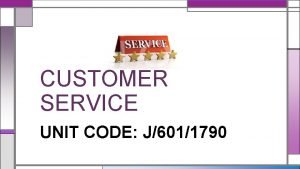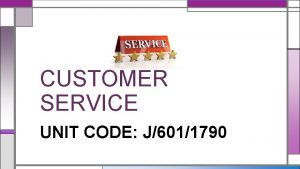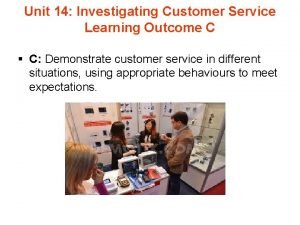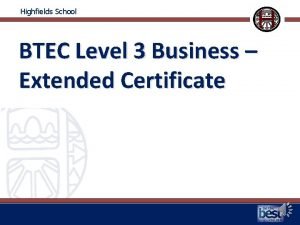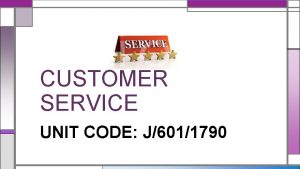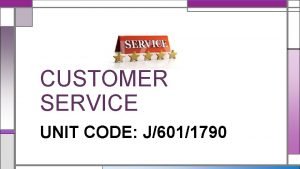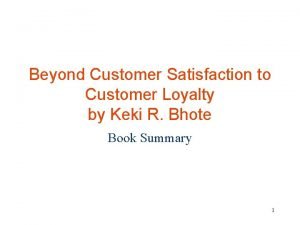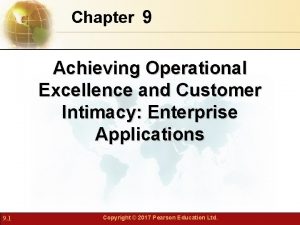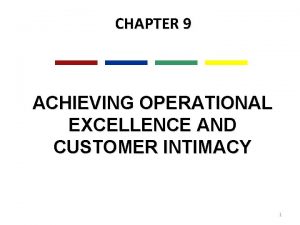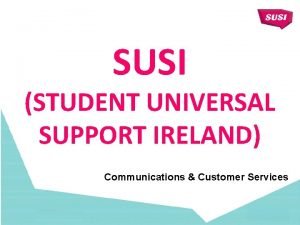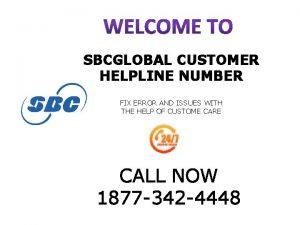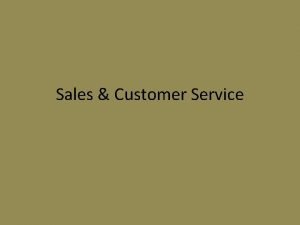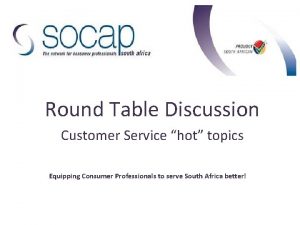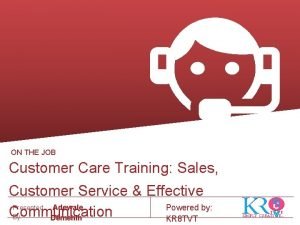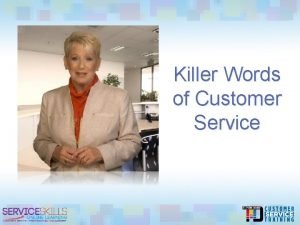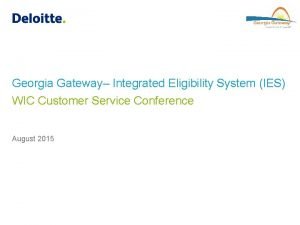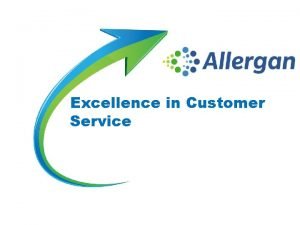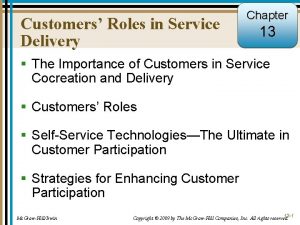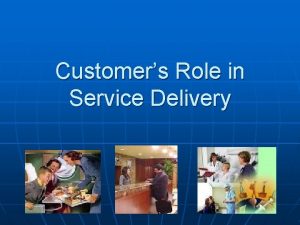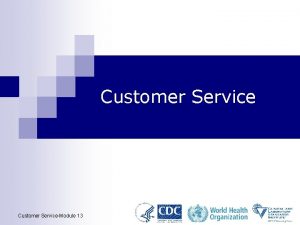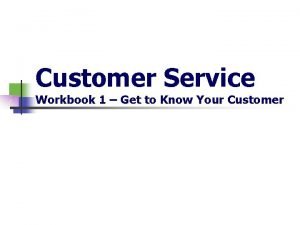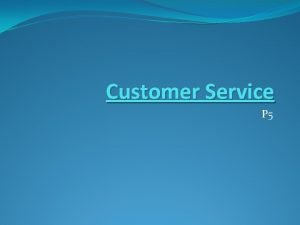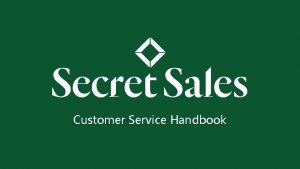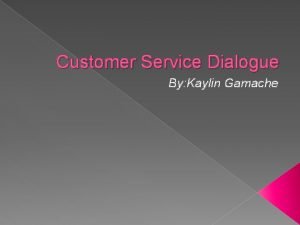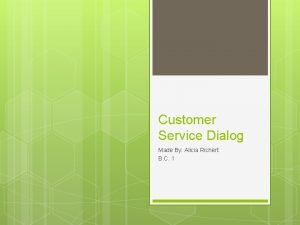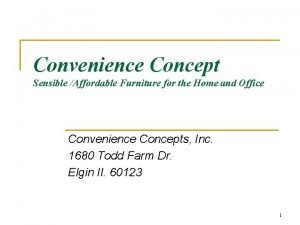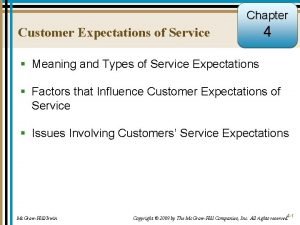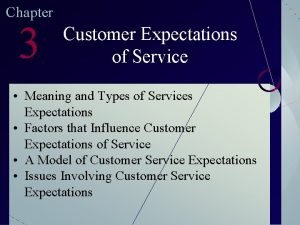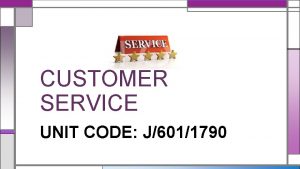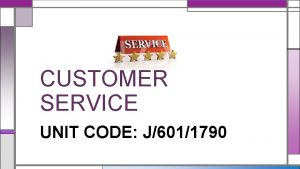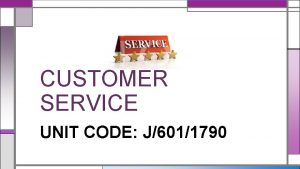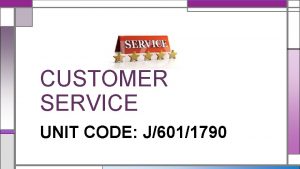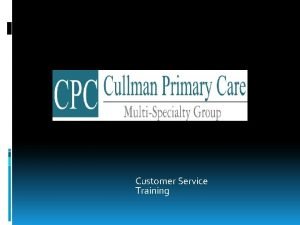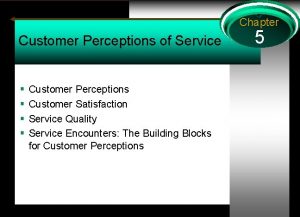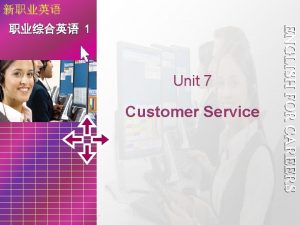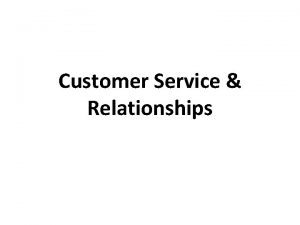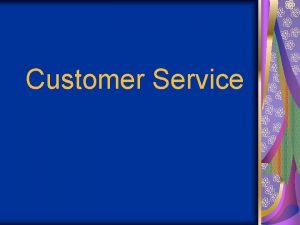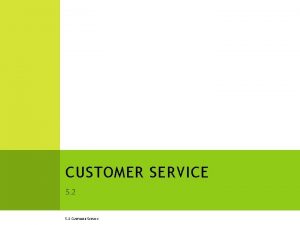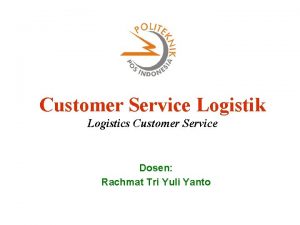CUSTOMER SERVICE UNIT CODE J6011790 UNIT 3 CUSTOMER












































- Slides: 44

CUSTOMER SERVICE UNIT CODE: J/601/1790

UNIT 3: CUSTOMER SERVICE • LEARNING OUTCOME 2: UNDERSTAND THE PURPOSE OF PROMOTING A CUSTOMER-FOCUESED CULTURE

THE BASIC SYLLABUS • 1. UNDERSTAND CUSTOMER SERVICE POLICIES WITHIN BUSINESS AND SERVICE CONTEXTS • 2. UNDERSTAND THE PURPOSE OF PROMOTING A CUSTOMERFOCUESED CULTURE. • 3. BE ABLE TO INVESTIGATE CUSTOMER REQUIREMENTS AND EXPECTATIONS • 4. BE ABLE TO PROVIDE CUSTOMER SERVICE WITHIN BUSINESS AND SERVICES CONTEXTS TO MEET REQIURED STANDARDS.

LEARNING OUTCOMES • UNDERSTAND THE PURPOSE OF PROMOTING A CUSTOMER-FOCUESED CULTURE. • AC 2. 1: EVALUATE DIFFERENT COMMUNICATION METHODS AND HOW THESE USED TO BEST EFFECT

OVERVIEW • Within the hospitality industry, staff rely on an ever-growing number of communication systems. It's critical to also have access to verification methods to ensure the right staff member receives the right notification in a timely matter. It has been demonstrated that a lack of integrated and effective communications can result in major gaps in the flow of time-sensitive information.

COMMUNICATION • Communication is a two-way process that results in a shared meaning or common understanding between the sender and the receiver. An understanding of how communication works can help us to understand improve our communication. The basic communication model consists of five elements of communication: the sender, the receiver, the message, the channel and feedback.

COMMUNICATION METHODS • Nothing can take place without some method of communication being used to express ourselves for whatever purpose. • Communication is even more valuable in a business environment as there are several parties involved. Various stakeholders, whether they are customers, employees or the media, are always sending important information to each other at all times. •

COMMUNICATION METHODS • We are therefore constantly using some form of communication or another to send a message across.

COMMUNICATION METHODS • Without these different methods of communication available today, it would take eons for us to carry out business as efficiently as it is done today and with the same speed.


COMMUNICATION METHODS • FACE TO FACE : The face-to-face communication is the personal mode of communication in which the participants can directly respond to signals of the counterpart (mimic and gesture). Such back couplings (feedback) between the communication partners in terms of queries and alternating conversation lead to immediate comprehension opportunities with a high flexibility. The immediate comprehension in the Face-to-Face communication enables a higher influence in comparison to mass communication. (van Koten 2011, marketicon 1 C).

COMMUNICATION METHODS • Berko et al. (2007) define face-to-face communication as a form of interpersonal communication (being part of human communication) that takes place between two or more persons who establish a communicative relationship. A rather technical explanation is given by Tubbs and Moss (2003): „[…] face-to-face communication is a multichannel experience. Simultaneously, we receive and make use of information from a number of different channels. The channels of face-to-face communication are the sensory organs. ”

COMMUNICATION METHODS • There are lots of different types of communication used in the hospitality industry. Verbal communication includes face-to-face communication and on the telephone and this kind of communication is used to exceed customers’ requirements such as; meet and greets and complaints. For example if a customer is making a complaint they would do this either on the telephone or face-to-face so verbal communication is key in this industry.

COMMUNICATION METHODS • WRITTEN: Next to oral communication, written communication is the oldest known form of communication. Any form of communication which is written and documented from the sender to the receiver is known as written communication. Examples of written communication include letters, memos, research papers, reports, etc. • Despite typically being a “hands-on” industry, hospitality workers need to pay attention to their written communication skills.

COMMUNICATION METHODS • Think about the importance of ensuring that accurate records are kept for function enquiries, table bookings, membership enquiries, phone messages, courtesy bus bookings. If your employees communicate via email, you need them to have a talent for the written word.

COMMUNICATION METHODS • TELEPHONE: With more and more business being done over the telephone and the increasing use of 24 hour professional call centres to handle customer enquiries, knowing how to have both face to face and effective phone communication skills is vitally important.

COMMUNICATION METHODS • Whether your hotel is a large five star resort or a small establishment in a little-known part of the countryside, your telephone is often the first point of direct contact with future guests. When someone calls, the phone receptionist is essentially making the sale of your product – a future stay at your establishment.

CUSTOMER SERVICE MANAGER AND COMMUNICATION METHODS • Customer service managers may be tasked with handling and responding to questions and concerns from clients through the phone, by email, in person or by letter. They also direct the customer services team to do their work and are tasked with developing the company’s customer service policy.

CUSTOMER SERVICE MANAGER AND COMMUNICATION METHODS • They need to be knowledgeable about the products and services that the organization offers because they give help and provide advice to customers about these. They may even be tasked to come up with customer resources such as reports or pamphlets about the company’s offers.

CUSTOMER SERVICE MANAGER AND COMMUNICATION METHODS • Although the work varies, depending on the type and size of the employing organisation, typical activities are likely to include some or all of the following: • -Providing help and advice to customers using your organisation's products or services;

CUSTOMER SERVICE MANAGER AND COMMUNICATION METHODS • -Communicating courteously with customers by telephone, email, letter and face to face;

UNIT 7 CUSTOMER SERVICE IN THE AVATION INDUSTRY UNIT CODE: A/504/2282 P 4: DISCUSS THE CONSEQUENCES ON COMMERCIAL AVAITION ORGANISATIONS OF PROVIDING INEFFECTIVE CUSTOMER SERVICE

THE CONSEQUENCES ON COMMERCIAL AVAITION ORGANISATIONS OF PROVIDING INEFFECTIVE CUSTOMER SERVICE • Poor customer service can ruin the reputation of any airline or a travel agency. If customer gets bad experience then neither he will use that supplier again nor will he advise anyone to use it again.

THE CONSEQUENCES ON COMMERCIAL AVAITION ORGANISATIONS OF PROVIDING INEFFECTIVE CUSTOMER SERVICE • So directly that supplier will lose that customer revenue in future and indirectly he will lose the prospective client which could get them a lot of business in the future.

UNIT 7 CUSTOMER SERVICE IN THE AVATION INDUSTRY • UNIT CODE: A/504/2282 • P 5: REVIEW DIFFERENT CUSTOMER SERVICE MODELS APPROPRIATE FOR USE IN THE AVIATION INDUSTRY

DIFFERENT CUSTOMER SERVICE MODELS APPROPRIATE FOR USE IN THE AVIATION INDUSTRY • A good customer service model focuses on increasing satisfaction while decreasing or minimizing customer conflict. Implementing a business model that focuses on an atmosphere of service is essential to the majority of businesses worldwide. Customer service models should include strategies for getting customer feedback, retaining angry or unsatisfied customers and continually updating policies and services to meet customers' needs.

DIFFERENT CUSTOMER SERVICE MODELS APPROPRIATE FOR USE IN THE AVIATION INDUSTRY • CUSTOMER RELATIONSHIP MANAGEMENT (CRM) • CRM is a strategic approach concerned with creating improved shareholder value through the development of appropriate relationships with key customers and customer segments. CRM unites the potential of relationship marketing strategies and IT [information technology] to create profitable, long-term relationships with customers and other key stakeholders.

DIFFERENT CUSTOMER SERVICE MODELS APPROPRIATE FOR USE IN THE AVIATION INDUSTRY • CUSTOMER RELATIONSHIP MANAGEMENT • CRM provides enhanced opportunities to use data and information to both understand customers and co-create value with them. This requires a crossfunctional integration of processes, people, operations and marketing capabilities that is enabled through information, technology and applications.

DIFFERRNT CUSTOMER SERVICE MODELS APPROPRIATE FOR USE IN THE AVIATION INDUSTRY • The RATER MODEL address these five points to deliver a star service. • The model highlights five areas that customers generally consider to be important when they use a service. These are: • Reliability – your ability to provide the service you have promised consistently, accurately, and on time.

DIFFERENT CUSTOMER SERVICE MODELS APPROPRIATE FOR USE IN THE AVIATION INDUSTRY • • Assurance – the knowledge, skills, and credibility of staff; and their ability to use this expertise to inspire trust and confidence. • Tangibles – the physical evidence of the service you provide. This could be offices, equipment, employees, and the communication and marketing materials that you use.

DIFFERENT CUSTOMER SERVICE MODELS APPROPRIATE FOR USE IN THE AVIATION INDUSTRY • • Empathy – the relationship between employees and customers. • Responsiveness – your ability to provide a quick, high quality service to your customers.

DIFFERENT CUSTOMER SERVICE MODELS APPROPRIATE FOR USE IN THE AVIATION INDUSTRY • The basis for great customer service is RESPECT. If customers do not feel respected, they will go elsewhere. Friends tell friends about great customer service experience – and friends not only listen, they act! If you want to create an environment that will lead to new customers walking in your doors everyday, get your staff trained in RESPECT!

DIFFERENT CUSTOMER SERVICE MODELS APPROPRIATE FOR USE IN THE AVIATION INDUSTRY • RESPONSIVE : Attend quickly to the needs of customers. The best customer service comes from being “prosponsive, ” i. e. , thinking and dealing proactively about customers’ needs. • EDUCATE : Provide customers with information that will help guide them to make the decision that best meets their needs, e. g. , services offered, how processes work, cost, time, alternatives, etc. By providing this information, you will not only demonstrate respect for them, you will also be demonstrating your knowledge and increase their confidence in you.

DIFFERENT CUSTOMER SERVICE MODELS APPROPRIATE FOR USE IN THE AVIATION INDUSTRY • SOLVE: Don’t just “resolve” a problem, try to solve it! The customer is not looking for excuses – they just want it taken care of and assurance that it won’t happen again. • PERSONALIZE: Give each customer that personal, friendly experience as if you are glad to seem them and happy to take care of them, e. g. , “Hey Greg, its good to see you today, come right here – I got you!

DIFFERENT CUSTOMER SERVICE MODELS APPROPRIATE FOR USE IN THE AVIATION INDUSTRY • EMPATHIZE: To empathize is to identify with another’s feelings, i. e. , put yourself in another’s shoes. Your goal is to diffuse the customer’s upset as quickly as possible. The most important thing is that the customer feels that they have been heard and that you understand that they are upset. Just because the situation may not seem like a big deal to you, it may be a huge deal to the customer!

DIFFERENT CUSTOMER SERVICE MODELS APPROPRIATE FOR USE IN THE AVIATION INDUSTRY • COURTEOUS: A professional CSR treats all customers and co-workers with patience, politeness, friendliness and consideration. • TEAMWORK: Work with your co-workers to provide the best service possible for your customers. In basketball, if I’m being heavily guarded, I don’t want to have to yell – “Someone help me!” – I expect a team member to jump in and help me out.

DIFFERENT CUSTOMER SERVICE MODELS APPROPRIATE FOR USE IN THE AVIATION INDUSTRY • Moments of truth are those interactions where customers put in a high amount of energy to reach a satisfactory outcome. A company could have thousands of moments of truth in a single day. Whether adversely or favourably, they incredibly affect companies’ relationship with customers and their perception about the brand.

DIFFERENT CUSTOMER SERVICE MODELS APPROPRIATE FOR USE IN THE AVIATION INDUSTRY • Some of the examples for it can be flight delay, a damaged product or even an advice to the customer. If companies give customers’ emotive needs precedence over their hard-set agendas, customer loyalty is the consequential emotional behaviour that these moments of truth would result in. And once customers are emotionally connected and rationally satisfied, that is when profitability would also come in.

DIFFERENT CUSTOMER SERVICE MODELS APPROPRIATE FOR USE IN THE AVIATION INDUSTRY • Customer development is used to help build products that customers want and avoid spending time and money on products customers don’t want. It can be used to identify problems and new start up ideas, to test ideas, and to optimize ideas and existing products. Customer development helps us learn about our potential customers.

DIFFERENT CUSTOMER SERVICE MODELS APPROPRIATE FOR USE IN THE AVIATION INDUSTRY • Customer development helps us learn about our potential customers. For example, what problems they have, how they understand those problems, and what’s really of value to them.

REFERENCES • "Hospitality Communications | Spok". Spok. com. N. p. , 2017. Web. 16 Jan. 2017. • "Communication". http: //www. aslect. eu/documents/case 1_Doing 2 learn/Doing 2 learn_Communication _Handbook. pdf. N. p. , 2017. Web. 16 Jan. 2017. • "Communication Methods". www. tutorialspoint. com. N. p. , 2017. Web. 16 Jan. 2017. • Garnett, Rebecca. "Customer Service - Communication!". Knowhospitality. blogspot. com. N. p. , 2017. Web. 16 Jan. 2017. • Team, Editorial. "Understanding Oral And Written Communication | Online Learning". Learn. geekinterview. com. N. p. , 2017. Web. 16 Jan. 2017.

REFERENCES • "Written Communication And The Hospitality Industry - Club Training Australia". Club Training Australia. N. p. , 2017. Web. 16 Jan. 2017. • ARNDT, CAROLIN. "The Importance Of Face-To-Face Communication In HR Departments". University of Gothenburg Department of Applied Information Technology Gothenburg, Sweden 1651 -4 (2011): n. pag. Web. 16 Jan. 2017. • "Hotel Management Company- Then Hospitality". Then Hospitality. N. p. , 2017. Web. 16 Jan. 2017. • "What Does A Customer Service Manager Do? - Career Igniter". Careerigniter. com. N. p. , 2017. Web. 16 Jan. 2017. • "Customer Service Manager Job Profile | Prospects. Ac. Uk". Prospects. ac. uk. N. p. , 2017. Web. 16 Jan. 2017.

REFERENCES • "Customer Service In Tourism Industry -". Vivocha. N. p. , 2017. Web. 16 Jan. 2017. • Schieltz, Matthew and Matthew Schieltz. "How To Develop A Customer Service Model | Ehow". e. How. N. p. , 2017. Web. 16 Jan. 2017. • BOLTON, RUTH N. and CRINA O TARASI. "MANAGING CUSTOMER RELATIONSHIPS". N. p. , 2017. Web. 18 Jan. 2017. • "RESPECT™ Model CUSTOMER SERVICE". http: //www. paulmarciano. com. N. p. , 2017. Web. 18 Jan. 2017. • Abbas, Rabail. "Customer Service Moments Of Truth". Customerservice. ae. N. p. , 2017. Web. 18 Jan. 2017.

REFERENCES • "What Is Customer Development And Why Should Entrepreneurs Practice It? ". The Huffington Post. N. p. , 2017. Web. 18 Jan. 2017.
 Pengertian customer relationship
Pengertian customer relationship My adp self portal
My adp self portal Busceral
Busceral Customer care policy
Customer care policy Unit 7 aviation
Unit 7 aviation Unit 14 customer service
Unit 14 customer service Unit 14 investigating customer service assignment 1
Unit 14 investigating customer service assignment 1 Buying signals from a customer
Buying signals from a customer Customer service unit
Customer service unit Customer service unit
Customer service unit Customer service unit
Customer service unit Marketing information and customer insights
Marketing information and customer insights Customer relationship management and customer intimacy
Customer relationship management and customer intimacy Beyond customer satisfaction to customer loyalty
Beyond customer satisfaction to customer loyalty Customer relationship management and customer intimacy
Customer relationship management and customer intimacy Intimacy
Intimacy Lso customer service
Lso customer service Strengths lists
Strengths lists Susi customer service
Susi customer service Remarkable customer support
Remarkable customer support Sbcglobal customer service number
Sbcglobal customer service number Types of customers in customer service
Types of customers in customer service Customer service discussion topics
Customer service discussion topics Customer service strategies in retail
Customer service strategies in retail Conflict resolution customer service
Conflict resolution customer service Good and bad customer service videos
Good and bad customer service videos Customer service objectives
Customer service objectives Customer name
Customer name Health equity customer service
Health equity customer service Hbr tools: swot analysis
Hbr tools: swot analysis Integrated eligibility system (ies)
Integrated eligibility system (ies) Allergan customer service
Allergan customer service Customer contributions and roles in service delivery
Customer contributions and roles in service delivery Role of customer in service delivery
Role of customer in service delivery Customer service module
Customer service module Customer service workbook
Customer service workbook A customer is someone who
A customer is someone who Customer service objectives
Customer service objectives Denial of receipt letter hermes
Denial of receipt letter hermes Dialogue customer service
Dialogue customer service Dialog for customer service
Dialog for customer service Customer service in public schools
Customer service in public schools Convenience concepts customer service
Convenience concepts customer service Do customer service expectations continually escalate
Do customer service expectations continually escalate Customer service expectations
Customer service expectations
